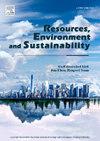Combatting environmental impacts and microbiological pollution risks in Potato cropping: Benefits of forage cultivation in a semi-arid region
IF 12.4
Q1 ENVIRONMENTAL SCIENCES
引用次数: 0
Abstract
Continuous potato cropping in semi-arid regions, which are vulnerable to erosion, reduces tuber yields and leads to a decline in soil quality. This research delves into the impact of forage cultivation on soil bacterial and archaeal communities and the associated hazard-related virulence genes and antibiotic resistance genes (ARGs) within potato cropping systems. The study reveals that distinct crop rotation schemes significantly alter soil physicochemical properties. Compared to non-potato cultivation, continuous potato cropping substantially reduces soil organic carbon from 31.9 g kg to 15.7 g kg and total nitrogen from 3.7 g kg to 1.6 g kg , indicating a notable deterioration in soil fertility. Among the ten identified phyla, Proteobacteria demonstrates the highest relative abundance, from 34.6% to 38.4%, closely followed by Actinobacteria, ranging from 20.5% to 36.0%. These two phyla likely play a crucial role in maintaining soil health. Moreover, continuous potato cultivation (CPC) results in more specific ARGs than non-potato cultivation (NPC). This phenomenon implies that CPC may select for particular resistance traits within the soil microbiome, potentially due to changes in the composition of the soil microbiota. Forage crops (oats or a mixture of oats and peas) exhibit varying effects on ARGs at different growth stages. The differences observed between the flowering and maturity stages of oats suggest that plant growth and the composition of root exudates can influence microbial communities and the prevalence of ARGs. The Mantel test further indicates that specific soil properties impact the abundance of certain microbial taxa and determine the expression of key functional genes, including those associated with antibiotic resistance. These findings underscore the intricate interactions among microbial communities, genes, and soil health, providing essential guidance for formulating agricultural practices to manage soil health and mitigating problems such as antibiotic resistance in continuously cropped soils.
Importantly, this study highlights the significant benefits of crop diversification, primarily through the incorporation of forage crops, in safeguarding soil health and maintaining microbial diversity within potato cropping systems. The results offer valuable perspectives for developing sustainable agricultural strategies, which can enhance soil fertility and promote ecosystem stability in semi-arid regions.

应对马铃薯种植的环境影响和微生物污染风险:半干旱地区牧草种植的效益
在易受侵蚀的半干旱地区,连续种植马铃薯会减少块茎产量,并导致土壤质量下降。本研究探讨了牧草栽培对马铃薯种植系统中土壤细菌和古细菌群落的影响以及相关的危害相关毒力基因和抗生素抗性基因(ARGs)。研究表明,不同的作物轮作方案显著改变了土壤的理化性质。与不种植马铃薯相比,连作马铃薯使土壤有机碳从31.9 g kg - 1减少到15.7 g kg - 1,全氮从3.7 g kg - 1减少到1.6 g kg - 1,土壤肥力明显下降。在10个门中,变形菌门的相对丰度最高,为34.6% ~ 38.4%,放线菌门次之,为20.5% ~ 36.0%。这两个门可能在维持土壤健康方面起着至关重要的作用。此外,连续马铃薯栽培(CPC)比非马铃薯栽培(NPC)产生更特异的ARGs。这一现象表明,CPC可能会在土壤微生物群中选择特定的抗性性状,这可能是由于土壤微生物群组成的变化。饲料作物(燕麦或燕麦和豌豆的混合物)在不同生长阶段对ARGs的影响不同。燕麦开花期和成熟期的差异表明,植物生长和根系分泌物的组成可以影响微生物群落和ARGs的流行。Mantel试验进一步表明,特定的土壤性质影响某些微生物类群的丰度,并决定关键功能基因的表达,包括那些与抗生素耐药性相关的基因。这些发现强调了微生物群落、基因和土壤健康之间复杂的相互作用,为制定农业实践以管理土壤健康和减轻连作土壤中的抗生素耐药性等问题提供了重要指导。重要的是,本研究强调了作物多样化的显著益处,主要是通过纳入饲料作物,在马铃薯种植系统中保护土壤健康和维持微生物多样性。研究结果为制定可持续农业战略提供了有价值的视角,可提高半干旱区土壤肥力,促进生态系统稳定。
本文章由计算机程序翻译,如有差异,请以英文原文为准。
求助全文
约1分钟内获得全文
求助全文
来源期刊

Resources Environment and Sustainability
Environmental Science-Environmental Science (miscellaneous)
CiteScore
15.10
自引率
0.00%
发文量
41
审稿时长
33 days
 求助内容:
求助内容: 应助结果提醒方式:
应助结果提醒方式:


